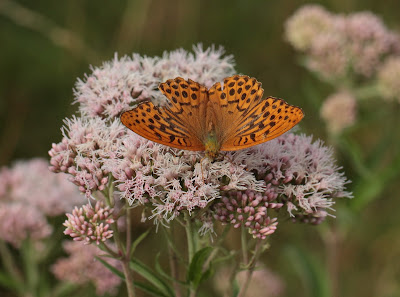Hemp Agrimony growing alongside the track near Meales House at Holkham
One
piece of valuable work that we undertake every winter and then on a couple of
occasions throughout the summer is to maintain the ride side vegetation
alongside the southern edge of the main pinewood track at Holkham. This
involves cutting back invasive bracken and reed to give more beneficial plants
breathing space. In doing so an
incredible habitat forms for an abundance of insects that are attracted by the bountiful
supply of nectar. One of the most numerous plants is Silverweed. As its name
suggests it has a silvery hue (on its jagged leaves) and is always one of the
first plants to emerge up in the spring. It is both abundant and subtle yet
could easily be overlooked even though its small yellow buttercup-like blooms
seems to be a constant feature of the rides all through the summer. Whereas
Silverweed is low growing ground cover, in contrast the dainty stems of Common
Centaury stand slightly taller. These pink members of the gentian family again
seem to be in flower all through the late spring and summer. Not only do they
grow on the ride sides but also in the older sand dunes of the reserve.
The beautiful and often numerous Peacock butterfly
The Great Pied Hoverfly, a striking looking insect
The
real draw for insects however are two more very different plants. One of them,
Hemp Agrimony, is impossible to overlook as it grows to just over a metre tall
and has a mass of tightly knitted pink blooms. The plant has long been used in
herbal remedies for treating cold, flu and high fever. For us at Holkham it is
our major source of summer nectar and an absolute magnet for insects,
butterflies in particular. From mid-July to mid-August take a walk past Meales
House and see for yourself. On a hot day the air above the plants will be
teaming with activity. Up to 27 species of butterfly alone have been recorded
over the years feeding on the plant. From tiny moth-like Small Skippers up to
the large and well known Red Admiral, all shapes, sizes and colours in between make
up this diverse group of insects. Here on the reserve we take part in a transect
organised by Butterfly Conservation to monitor trends and abundance of all the
butterflies. It involves walking the same route weekly, something that has been
done continuously since 1976 and is one of the longest constant effort sites in
the country.
At Holkham we have been
lucky, we have yet to actually lose any species, in fact we have actually
gained 11 species. Surprisingly some common species were not noted initially.
The first Comma (now a common species) was recorded on the transect in 1980, the
first Holly Blue in 1991 and White Admiral in 2003. All are distinctive in their looks and with
patience and luck all can be seen at Holkham in July. This year we have seen large numbers of Red
Admirals, three years ago it was all Peacocks and Painted Ladies. You might
even be lucky and see a scarcity such as a White-letter or Purple Hairstreak or
a Silver-washed Fritillary. The latter is very large black striped orange
species that has only moved to Norfolk in recent years from woodlands in the
south of England. The variety of butterfly colours can be overwhelming when
seen for the first time!
The Silver-washed Fritillary, once rare in Norfolk but now on the increase
Another
more subtle plant that grows along the same ride, yet blooms slightly later is
Fleabane. This warm yellow plant also grows in thick clumps but unlike Hemp
Agrimony is lower growing (standing about 60 cm tall) and hence seems to
attract a variety of the smaller butterflies such as Common Blues, Small
Coppers and Brown Argus. Fleabane too had old traditional values. As its name
suggests it was used as an incense to repel insects, while another use was as a
cure for dysentery.
Longhorn beetles can be distinguished by their over-long antennae, this species is called the Golden-plumed Grey Longhorn
As
well as butterflies the flowering plants of the woods attract an array of bees,
hoverflies, dragonflies, damselflies and beetles, too numerous to mention here!
Keep a particular eye out for longhorn beetles, these can truly be spectacular.
With overlong antennae they can look both comical and fearsome at the same
time! So if you want to witness this mini spectacle of beasts and bugs come
along before the summer is out or put a date in your diary for next year.
Andy
Bloomfield, Warden





